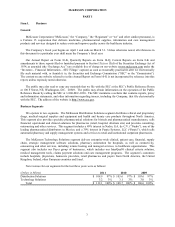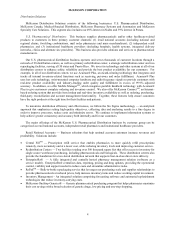McKesson 2011 Annual Report Download - page 18
Download and view the complete annual report
Please find page 18 of the 2011 McKesson annual report below. You can navigate through the pages in the report by either clicking on the pages listed below, or by using the keyword search tool below to find specific information within the annual report.McKESSON CORPORATION
12
Changes in the United States healthcare industry and regulatory environment could have a material adverse
impact on our results of operations.
Our products and services are primarily intended to function within the structure of the healthcare financing and
reimbursement system currently being used in the United States. In recent years, the healthcare industry in the
United States has changed significantly in an effort to reduce costs. These changes have included increased use of
managed care, cuts in Medicare and Medicaid reimbursement levels, consolidation of pharmaceutical and medical-
surgical supply distributors and the development of large, sophisticated purchasing groups. We expect the
healthcare industry in the United States to continue to change and for healthcare delivery models to evolve in the
future.
Changes in the healthcare industry’s or our pharmaceutical suppliers’ pricing, selling, inventory, distribution or
supply policies or practices could significantly reduce our revenues and net income. Due to the diverse range of
healthcare supply management and healthcare information technology products and services that we offer, such
changes could have a material adverse impact on our results of operations, while not affecting some of our
competitors who offer a narrower range of products and services.
The majority of our U.S. pharmaceutical distribution business’ agreements with manufacturers are structured to
ensure that we are appropriately and predictably compensated for the services we provide; however, failure to
successfully renew these contracts in a timely and favorable manner could have a material adverse impact on our
results of operations. In addition, branded price inflation can be the partial economic basis of some of our
distribution business agreements with pharmaceutical manufacturers. If the frequency or rate of branded price
increases slows, it could have a material adverse impact on our results of operations.
In addition, we also distribute generic pharmaceuticals, which can be subject to both price deflation and price
inflation. Healthcare and public policy trends indicate that the number of generic drugs will increase over the next
few years as a result of the expiration of certain drug patents. In recent years, our financial results have improved
from our generic drug offerings. An increase or a decrease in the availability or changes in pricing trends or
reimbursement of these generic drugs could have a material adverse impact on our results of operations.
Generic drug manufacturers are increasingly challenging the validity or enforceability of patents on branded
pharmaceutical products. During the pendency of these legal challenges, a generics manufacturer may begin
manufacturing and selling a generic version of the branded product prior to the final resolution to its legal challenge
over the branded product’s patent. To the extent we source and distribute such generic products launched “at risk,”
the brand-name company could assert infringement claims against us. While we generally obtain indemnification
against such claims from generic manufacturers as a condition of distributing their products, there can be no
assurances that these rights will be adequate or sufficient to protect us.
In recent years, the pharmaceutical suppliers have been subject to increasing consolidation. As a result, a small
number of very large companies control a significant share of the market. Accordingly, we depend on fewer
suppliers for our products and therefore we may be less able to negotiate price terms with suppliers.
Many healthcare organizations also have consolidated to create larger healthcare enterprises with greater market
power. If this consolidation trend continues, it could reduce the size of our target market and give the resulting
enterprises greater bargaining power, which may lead to erosion of the prices for our products and services. In
addition, when healthcare organizations combine they often consolidate infrastructure including IT systems, which
in turn may erode our customer and revenue base.
The healthcare industry is highly regulated, and further regulation of our distribution businesses and computer-
related products and services could impose increased costs, negatively impact our profit margins and the profit
margins of our customers, delay the introduction or implementation of our new products, or otherwise negatively
impact our business and expose the Company to litigation and regulatory investigations.
























